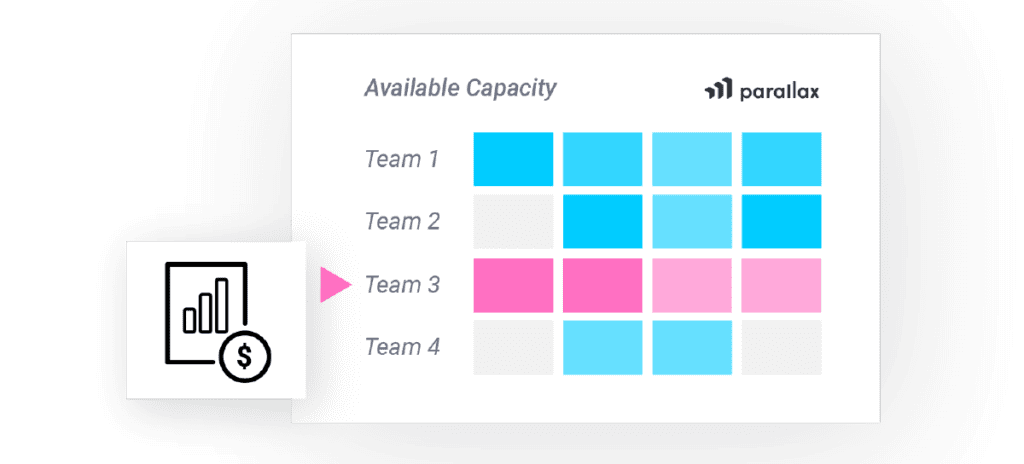Best Practices for Agency Capacity Planning 2023

Digital agencies and shops are on a never-ending journey when it comes to maximizing the potential of their resources and staying ahead of the curve while also keeping costs under control. To do so, they rely on capacity planning: a crucial component of the services industry that can make or break the profitability and competitiveness of businesses.
New to capacity planning or looking to refine your approach? We explore best practices and provide insights on how you can master capacity planning, optimize your resources, and set your business up for near- and long-term success. 😎
Table of Contents
- What is capacity planning?
- Without capacity planning…
- With capacity planning
- 5 best practices to adopt
- A solution that works with your existing toolset
- Capacity planning with Parallax
- Capacity planning FAQ
What is Capacity Planning?
Consider how many agencies make hiring decisions based on customer demand, which tends to happen in a near-term, reactive nature. You win new work, and you scramble to hire quickly to have the resources ready by the start date. Sound familiar?
Capacity planning helps agencies understand what kind of services and/or products their customers and prospects want now and helps predict what they will want in the future. When capacity planning is done right, it allows leaders to confidently invest in resources that will support their organization’s future rather than resources or skill sets that eventually won’t be needed or desired based on industry trends or social or cultural impact.
This isn’t a sustainable approach for a number of reasons:
- Existing teams are pulled apart to take on the new work, which can lead to poor performance on existing work due to scrambling, lost team members, and the distraction of moving teams around.
- The new work may not start off on the best foot because either it’s understaffed OR, again, the team is scrambling to make the right people available.
Ultimately, in these scenarios, teams usually aren’t performing at their best—and the quality of work on both new and existing projects starts to dip. The solution is to get ahead of the capacity demand by confidently understanding what’s in the backlog AND pipeline further out.
Without Capacity Planning…
First, why aren’t more leaders resource planning for the here and now AND forecasting for future demand?
Short answer: It’s not easy!
Long answer: Implementing capacity planning best practices can be challenging for organizations, especially those that are new to the process or don’t have the right tools in their toolbox to help. Unfortunately, they might not even realize some of the day-to-day issues they’re experiencing are a symptom of poor (or nonexistent) capacity planning:
- Unpredictable highs and lows in utilization: “What-if” scenarios for incoming work and how new projects could or could not align to your team’s capacity aren’t easily mapped out (if created at all). This results in a rollercoaster ride of too much work or not enough work for teams, with their utilization rates spiking too high and burning people out or dropping too low, with leaders potentially having to make some difficult staffing decisions.
- Reactive project scoping: Delivery teams aren’t aware of projects coming down the pipeline, so they can’t proactively optimize resourcing. Scoping, pricing and setting a timeline for projects becomes time-consuming and chaotic—as a result, there’s a lot of “we need to kick off this project tomorrow” triage that causes tension between Sales and Delivery teams, which inevitably trickles down to the rest of the organization.
- Incomplete forecasting insights: Resourcing plans that only account for secured work, not in-pipeline deals, make it difficult for leaders and resource managers to be sure which specific skills are needed (and if they’re even available) for projects that are about to kickoff. It becomes a never-ending resourcing scramble for the agency that impacts team morale and can even jeopardize client relationships.
With Capacity Planning…
Proper capacity planning can help eliminate these everyday frustrations, which ultimately impact the success of services organizations. Leaders can regain confidence in their forecasts. Teams can regain confidence in their leaders. And everyone is happier, working with a shared perspective and towards the same goals. 🔥Here’s how we recommend getting there:
5 Capacity Planning Best Practices to Adopt
- Account for BOTH secured and in-pipeline deals in forecasts: When you assess resourcing needs for both secured and in-pipeline deals, you can finally effectively and efficiently manage your resources, ensuring that each project has the appropriate amount and kind of resources allocated to it.
This requires moving from a 1-4 week forecast that only includes secured work to a 12-18 week forecast that accounts for in-pipeline deals. Keep in mind that this more holistic forecast won’t be perfect, as things will undoubtedly change. But it will provide a directionally accurate starting point that you can make small adjustments to each week as needed. The result? Resources are available and ready, not wasted or overburdened. Projects start on time, are completed on time, and stay within budget. Clients are happy and keep coming back for more.
- Create a shared perspective for all business functions: When you streamline communication between Sales and Delivery teams and gather all relevant information about both secured and in-pipeline deals into one view or within one platform, teams start working with each other rather than against each other. Surprises are eliminated, tension is reduced, and everyone starts marching to the same beat.
- Develop contingency plans for unexpected events: Developing contingency or “what-if” plans for unexpected resource demands or disruptions ensures you’re never totally caught off guard. Having these plans in place allow businesses to respond quickly to unexpected events and minimize the impact on resource utilization, keeping stress low and confidence high.
- Regularly track and review plans and forecasts: It could almost go without saying, but tracking and updating capacity plans and forecasts is a must. This helps you identify areas for improvement and helps you stay on top of utilization rates so you can make necessary adjustments to optimize resources as needed.
- Leverage technology purpose-built for capacity planning: Implementing software that’s designed to support and elevate capacity planning processes is a no-brainer. This not only helps leaders ensure that each resource is utilized to its fullest potential, but the right software (see below 😉) can support better project outcomes and higher client satisfaction, ultimately leading to increased profitability.

A Seamless Solution That Works With Your Existing Toolset
From our experience, it’s crucial to 1) sustain your business 2) grow your business and 3) keep your talent happy and fulfilled by implementing capacity planning best practices.
That’s what we help you achieve at Parallax. We understand the importance of maintaining business continuity and minimizing disruptions, which is why our software is designed to integrate seamlessly with your existing toolset, ensuring a smooth transition and minimizing the learning curve for your team. By leveraging the tools you already know and love, Parallax can help you streamline your capacity planning processes, optimize your resources, and achieve greater efficiency and profitability without causing any major disruptions to your existing workflows. In other words, we got your back, and we want to see you succeed. 🤜🤛
Capacity Planning with Parallax
Don’t let the fear of disruption hold you back from improving operational workflows and unlocking a forward-looking view into your business and industry. Here’s what you gain with Parallax:
- Transparent Project Pricing: Sales can create an opportunity in the CRM and attach a service offering template to the deal, which can be adjusted to however you price or structure your deals. Sales then has pricing without manual meetings with Delivery, and the deal amount drives the target budget the project will be tracked to.
- Smooth Project Scoping: The same template captures the specific skills needed for a project and outlines when the project can start based on resource availability. Delivery can then see upcoming projects early and can see projected start dates based on close date from the CRM deal.
- Holistic Capacity Forecasts: Allocation of people on projects automatically earmarks team members time to give leadership, Delivery, and Sales teams a view on projects they can sell, timing of those projects, and who’s available (or not available) for those projects. Everyone can easily view total capacity, total billable capacity, remaining project hours, sales pipeline allocations, and actuals.
- Easy Scenario Planning: Leaders and resource managers can filter pipeline opportunities onto current capacity to better understand “what-if” scenarios on how they’ll be able to handle potential incoming work along with existing, secured projects.
- Service Offering Insights: Leaders can quickly see what services are in high demand and are most profitable and compare them against upcoming projects to inform hiring decisions and adapt offerings to those types of services.
- Focused Sales Efforts: With a view of future capacity based on secured projects as well as potential pipeline projects, leaders and Sales teams gain clarity on what services are in high and low demand, giving them the ability to focus sales efforts on services with available capacity.
If it’s not obvious, our team at Parallax loves solving capacity and resourcing problems so that your business can stay competitive. The added bonus? You can keep your focus on what truly matters: your people and the health of your business.
If you want to talk through your capacity planning challenges, we’re here for you. We might even be able to help solve them. 😜 Reach out today, and we can get started on a solution together: https://www.getparallax.com/book-a-demo.
Capacity Planning FAQ
What is capacity planning and why is it important for a digital agency?
Capacity planning helps agencies understand what kind of services and/or products their customers and prospects want now and helps predict what they will want in the future. It allows leaders to confidently invest in resources that will support their organization’s future rather than resources or skill sets that eventually won’t be needed or desired based on industry trends or social or cultural impact.
What are some common challenges that digital agencies face when it comes to capacity planning?
Day-to-day issues such as unpredictable highs and lows in utilization, reactive project scoping, and incomplete forecasting insights that lead to resourcing scrambles are often a symptom of poor or nonexistent capacity planning. It can be difficult to implement capacity planning best practices, however, without the right tools to help and if an agency is new to the process.
How can a digital agency balance capacity planning with the need for flexibility?
Capacity planning and strategic forecasting are meant to guide the organization and inform the decision-making process. They’re not meant to be set in stone and never adjusted. Tracking and updating capacity plans and forecasts is a must, as it helps leaders identify areas for improvement and allows them to stay on top of utilization rates so they can make necessary adjustments to optimize resources as needed.
What are some best practices for capacity planning in a digital agency?
Best practices for capacity planning include accounting for both secured and in-pipeline deals in forecasts, creating a shared perspective for all business functions, developing contingency plans for unexpected events, regularly tracking and reviewing plans and forecasts, and leveraging technology purpose-built for capacity planning.


